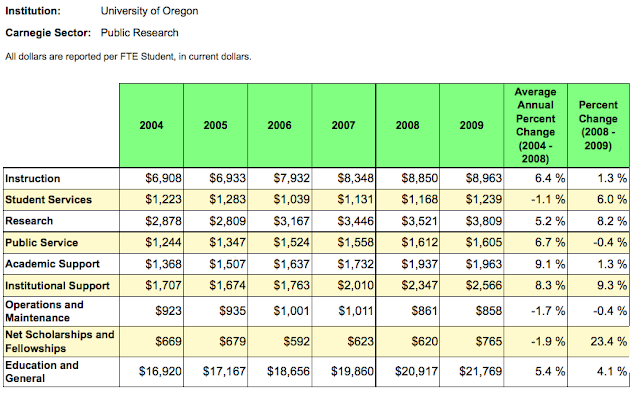 |
9/24/2011: This graph from UO’s latest report to OUS on our “academic plan” certainly raises the question. See this earlier post for background.
Since 2001 undergraduate enrollment has increased 36%, graduate enrollment by less than 10%, and the number of tenure track faculty by less than 10%. |
| Here’s the data on the number of tenure track faculty – pretty flat with a recent small uptick. Here’s the data on enrollment. We have 24,300 this year.
To the left is the number of students (fall enrollments) per tenure track faculty. For 2011, it will be ~35. |
|
And here’s the latest IPEDS data on where the money is going, from the Delta Project. 2009 means the 2009-2010 academic year, President Lariviere’s first year in charge. 1.3% increase in instructional spending and a 9.3% increase on institutional support – meaning central administrative costs, aka Johnson Hall.
From their data dictionary: “General administrative services, executive management, legal and fiscal operations, public relations and central operations for physical operation.” I wonder what the 2010-2011 data will look like?
The good news is that the faculty did well getting grants – research spending was up 8.2% over 2008. Go here for background and sources. Revenue? Tuition up, state support down. (Auxiliary services means dorms, food service, parking.)



Dog says
kudos to UOmatters for posting the actual data. I have been bitching about this for years (since I am a bitch).
Just to add another statistic. The total PHD production rate for the UO is about 3.5% of all
degrees (data from IR) – this must be at the bottom of all “research” universities.
Bottom line – for whatever reason and for whomever to blame – the UO has not paid attention to the necessity of a robust graduate student resource for at least a decade.
This is shameful!
so TT faculty numbers were the same in 1992 and 2008 — shows where the emphasis wasn’t during the years of a certain Pres — since then an increase of about 30. That is actually a good rate — if they ramp up the number of TT faculty too fast, they’ll probably compromise quality — plus, it’s entirely possible, if there’s ever an economic recovery, that we’ll see a drop in enrollment. Or the same, if there isn’t an economic recovery. So I would say they are doing this the right way.
I hope to soon have data on administrative head counts and expenditures over this period.
You will find that administrative budget has grown much faster than the instructional budget. I think you’ll also find that it has grown faster than the total budget — perhaps a fairer comparison.
Groucho – do you have any idea where to get recent data on that?
Thanks for the suggestions, Professor Firefly. The IPEDS data is a year + old, and as you note it’s the last few years which are most interesting. Let me know if you come across anything else, and I’ll follow up o your other ideas. (Did you want me to post those or not?)
Anon #2, I don’t think so. For one thing, there’s a recession – lots of good hires are available, right now. For another, we need the faculty to help out now – or the ones we’ve got will pack up to places that are better run.
Dog says,
yes maybe the “uptick” in faculty TT hires will
continue – it should.
I think a useful ratio, which basically tells you everything you need to know about academic
priorities at the UO, is to compare 1996 to 2010
in terms of UG/TT (1996 is chosen as being the
most favorable)
1996: 13522/661 = 20.45
2010: 19220/683 = 28.14 (40% increase)
this indicative ratio should decrease with
time, if academic quality matters.
I defy you to find another University that
shows such a significant increase in UG/TT
over the last 15 years.
Again, our UG/TT means we are a community
college, in practice.
related:
http://reclaimuc.blogspot.com/2011/09/senior-administrators-now-officially.html